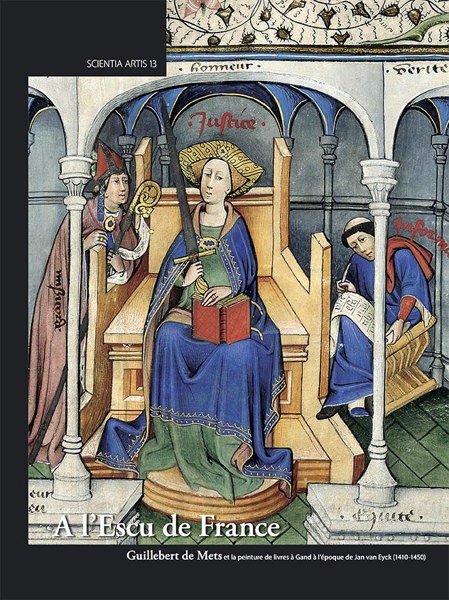
A Masterly Hand. Interdisciplinary Research on the Late-Medieval Sculptor(s) Master of Elsloo in an International Perspective
Proceedings of the Conference held at the Royal Institute for Cultural Heritage in Brussels on 20-21 October 2011
Famke Peters, Christina Ceulemans (eds)
- Pages: 345 p.
- Size:230 x 290 mm
- Language(s):English, French, Dutch
- Publication Year:2014
- € 60,00 EXCL. VAT RETAIL PRICE
- ISBN: 978-2-930054-19-3
- Paperback
- Available
A stylistic study augmented by an extensive examination of the materials and techniques employed by the woodcarvers grouped under the sobriquet of ‘Master of Elsloo’ with particular emphasis on workbench marks and the remains of any original polychromy.
In 1940 the art historian J.J.M. Timmers introduced the name ‘Master of Elsloo’ to describe the anonymous creator of a late-Gothic wooden statue of St Anne with the Virgin and Child in St Augustine’s Church in Elsloo, a town in Limburg in the present-day Netherlands. In the following decades many other stylistically-related statues came to be associated with the St Anne. As a result, the Master of Elsloo’s oeuvre grew to include at least two-hundred works. Until recently, studies of these sculptures and their maker(s) have been almost exclusively stylistic in approach. Yet the works of the ‘Master of Elsloo’ evoke many questions that require thorough investigation. Questions about the identity of the woodcarver or, more likely, the woodcarvers grouped under the sobriquet of ‘Master of Elsloo’, their artistic roots, their period and place of activity, and the organisation of their work in the workshop or shops.
The major interdisciplinary research project carried out in 2010-2011 by the Royal Institute for Cultural Heritage in Brussels together with partners from Belgium and other countries was intended to shed new light on this sizeable group of statues and their makers. This time stylistic study was augmented by extensive examination of the materials and techniques employed with particular emphasis on workbench marks and the remains of any original polychromy. Also extremely important was the dendrochronological analysis of a large number of sculptures, which led to surprising results regarding the origin of the wood and the relationship between the works. A number of complementary studies help to situate the ‘Master of Elsloo’ more accurately in ‘his’ historical and artistic context. The results of all these studies were presented as papers at the colloquium organised by the Royal Institute for Cultural Heritage on 20 and 21 October 2011. A Masterly Hand. Interdisciplinary Research on the Late-Medieval Sculptor(s) Master of Elsloo in an International Perspective brings together the project’s findings, to which are added an inventory of works associated with the ‘Master of Elsloo’ and the results of new archival research.
The Scientia Artis series is published by the Royal Institute for Cultural Heritage (kik-irpa, Brussels). The works in this series – monographs, exhibition catalogues and conference proceedings – present the results of research projects and scientific events (co-)organised by the kik-irpa. Since 1948 this Federal Scientific Institution has been charged with the study, protection and promotion of Belgium’s cultural heritage. www.kikirpa.be
Foreword (Christina Ceulemans) – Notes to the Reader – Introduction and Acknowledgements (Famke Peters and Christina Ceulemans)
Peter te Poel, De wordingsgeschiedenis van een ‘meester’
Gerard Venner, De herkomst van de Sint-Anna te Drieën in de parochiekerk te Elsloo: een reconstructie van de geschiedenis van een referentiebeeld
Gerard Venner, Beeldsnijders en andere kunstenaars in Roermondse en Venlose bronnen
Famke Peters, Introduction to the KIK-IRPA’s Interdisciplinary Research on the Sculptures from the Elsloo Group in Belgium, and in particular the Methodology of the Art-historical Research
Famke Peters and Vincent Cattersel, In Search of the Elsloo DNA: Stylistic Study of Sculptures from the Elsloo Group
Michel Lefftz, Réflexions méthodologiques et contribution à la caractérisation morphologique des sculptures du groupe d’Elsloo
Kim Woods, Sculpture from the Elsloo Group in England
Pascale Fraiture, Dendrochronological Research on Sculptures from the Elsloo Group
Jana Sanyova and Cécile Glaude, La polychromie de quelques sculptures du groupe d’Elsloo
Vincent Cattersel, Methodology and Results of the Technical Research of Seventy-Seven Statues from the Elsloo Group, Mainly Preserved in Belgium
Arnold Truyen, Technical Study of the St Anne with the Virgin and Child in Elsloo and some other Sculptures Associated with the Master of Elsloo
Marc Peez, Die spätgotischen Skulpturen und der Lettnerbogen in der St. Johannes-Kirche in Siersdorf: ein Beitrag zur Werktechnik
Vincent Cattersel, Het Christusbeeld van de Calvariegroep uit de Sint-Harlindis-en-Relindiskerk te Ellikom: een bijzondere casus
Emmanuelle Mercier and Delphine Steyaert, The Virgin and Child on the Crescent Moon from St James’s Church in Liège and Sculpture Polychromy in the Low Countries at the Time of the ‘Master of Elsloo’: a Typological Approach
Lucretia Kargère, The Metropolitan Museum of Art’s St Roch: looking at Artistic Workshops Around the ‘Master of Elsloo’
Michel Lefftz, Maître Balthazar (Baltus de Ryckel[le]?), un contemporain du Maître d’Elsloo à Liège: un inventaire provisoire
Famke Peters, Limburgse beelden onder handen genomen: archiefdocumenten als bron voor de reconstructie van een stuk restauratiegeschiedenis
Conclusion (Famke Peters and Christina Ceulemans) – Inventory of Works from the Elsloo Group – Illustration Credits




